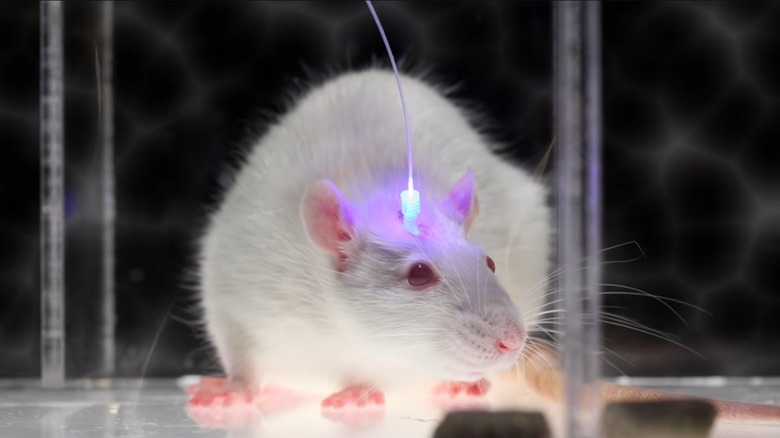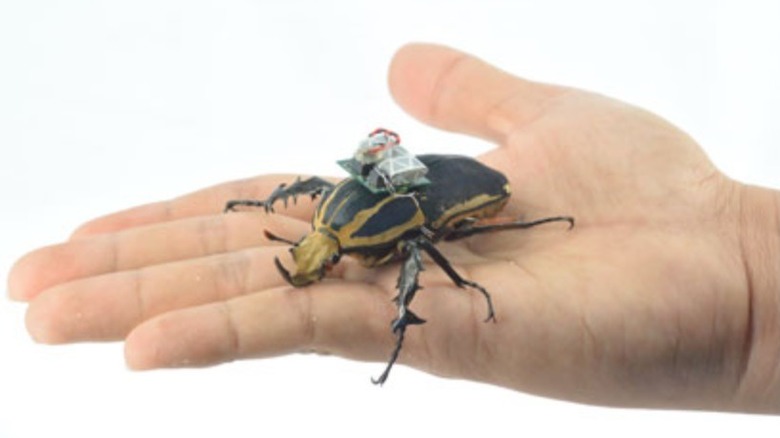Science Experiments With Terrifying Consequences
The scientific method is perhaps the most important innovation humanity has ever created. The rigorous process of probing the natural world, designing experiments, and making observations has transformed us from mere primates into a species capable of bending the world to our will.
Over the last several thousand years we have built cities, crossed oceans, and explored corners of the universe both microscopic and cosmic in scale. We split the atom, eradicated disease, developed global communications systems, and walked on the moon all through the power of scientific exploration.
The trouble is that science necessarily operates at the fringes of human knowledge. Every experiment is shining a light on an unknown, and sometimes when we poke at an unknown, it pokes back. While the aggregate of scientific inquiry has been a net good for our species, experimentation isn't without its costs, and scientists sometimes bend the world in precisely the wrong way, with terrifying results.
The demon core
In 1945, the United States dropped nuclear bombs on the Japanese cities of Hiroshima and Nagasaki. The United States military had plans to drop a third bomb, but after the devastation of the first two, Japan surrendered, and the third detonation was canceled. As a result, scientists at Los Alamos were left holding the active core of a nuclear bomb (via Science Alert).
Rather than dispose of the core, scientists kept it in the lab and performed experiments on it. They wanted to know the precise point at which the plutonium goes supercritical. To find out, they would surround the plutonium sphere with bricks made of tungsten carbide. Only a week after Japan surrendered, the core claimed its first life when Harry Daghlian placed one brick too many, causing it to go supercritical. Daghlian received a fatal dose of radiation and died 25 days later.
A few months later the core took its second victim. In fact, this time eight people received a dangerous dose of radiation, one of whom died. After the second death, the plutonium sphere received a new name and has since been known as the demon core (via The New Yorker).
Particle accelerator collision
When the Large Hadron Collider was about to come online, some were concerned that it might create a black hole and swallow the Earth (via CERN). Obviously, that didn't happen, but a particle accelerator did once result in a personal big bang for a Russian physicist in 1978.
Anatoli Bugorski was working on a particle accelerator he believed to be offline. In addition to the maintenance he was there to do, the warning lights had also broken, meaning Bugorski had no hint that the accelerator was operating while he was in the room. During the course of his examination, Bugorski leaned into the path of the beam, receiving a burst of high-energy protons that traveled through the back of his head and out the left side of his face (via Discover).
Bugorski reported seeing a bright flash of light as a dose of radiation hundreds of times higher than fatal levels traveled through his brain. Shockingly, Bugorski not only survived the accident but he's still alive at the time of this writing. Although, he didn't escape the accident unscathed. In the days after the accident, the left side of his head swelled, and the skin blistered and peeled where the beam made contact. Later, he lost hearing in his left ear and experienced mental fatigue, seizures, and eventual facial paralysis.
The Stanford Prison Experiment
In 1971, the U.S. Office of Naval Research funded a two-week social experiment at Stanford University. The study sought to see how people behave under the influence of a power imbalance and used a simulated prison setting as a testbed. Researchers released an advertisement soliciting volunteers for a psychological study of prison life (via Britannica) and received more than 70 responses, from whom 24 people were selected.
Half of the participants were selected to play the part of a prisoner while the other half were prison guards. Researchers went as far as to have the fake prisoners arrested by actual police officers and delivered to a mock prison in the basement of the psych building (via Stanford Magazine).
The conditions in the simulated prison quickly degraded. By the second day, the prisoners had staged a rebellion and by day four, some of the participants were so traumatized they had to be sent home. By the sixth day, the experiment had descended into chaos, and it was halted before even reaching the halfway point of its planned two-week duration. Some believe that the experiment was doomed from the start, suggesting that soliciting volunteers for the express purpose of simulating a prison environment attracted people predisposed to abuses of power. Whatever the cause, it's an example of how experiments can go wrong when not rigorously designed and how quickly we can awaken our worst characteristics when given the chance.
Gua and Donald
For centuries we've told stories of feral children living outside the bounds of human civilization. In the stories, they live alone in the wild or with non-human animals, and they behave as if they are animals themselves. For a long time, these stories were unconfirmed, the stuff of myth or legend, but by the 20th century, the confirmed discovery of several so-called feral children (via History) sparked interest in the effects of nurture and nature. If raising a human in the wild makes them wild, then would raising an animal in civilization make them civilized?
That's the question comparative psychologist Niles Kellogg set out to answer in 1931 when he brought a chimp into his home and raised it alongside his infant son. As reported by Smithsonian Magazine, the babies, named Donald and Gua, were raised together as if they were siblings, in the hope that Gua would stretch beyond the behavioral limits of her wild peers.
At first, Gua did better than Donald on cognitive tests, but she eventually hit a wall and plateaued. Exposure to a human environment may have impacted the rate of development leading up to that wall but Gua couldn't get past the limitations of her genetics. In fact, not only did the experiment fail to make Gua behave more like a human, it succeeded in the opposite. Donald was imitating Gua and may have had his human language development hindered. It's possible that was the reason the experiment ultimately ended.
British anthrax simulation
One of the downsides of scientific discovery is that almost as soon as we learn something new, someone figures out how to turn it into a weapon. As our understanding of biology increased, so did our fear of an attack from a biological weapon. In the '50s and '60s, scientists in London conducted a series of experiments simulating a biological weapon attack in order to identify the city's potential vulnerabilities.
According to The Guardian, researchers used a microscopic spore that mimics the behavior of the anthrax spore, with the important difference that the experimental spore was non-fatal. Experiments included dropping a container of spores from a moving underground train, as well as directly spraying spores on target locations within underground tunnels. Researchers then measured the spread of the spores throughout the tunnel system and the city overhead.
The experiments revealed that such an attack could easily spread throughout a population or area, including the heart of the British government, in the days and weeks before anyone became symptomatic. By the time the experiments were over the conclusion was clear, a well-executed biological attack would be relatively easy to carry out and potentially catastrophic.
Vladimir Demikhov's two-headed dog
In 1959, Russian scientist Vladimir Demikhov was working hard on becoming a real life mad scientist. His experiments were among the earliest in organ and tissue transplant research and involved activities like sewing extra organs onto the outside of living animals and eventually sewing dogs together, creating surgical chimera.
As reported by Vice, the operation to surgically connect a portion of one dog to the body of another was painstaking. Demikhov had to identify every blood vessel and tie them off as he cut a smaller dog in half. Later, he would have to laboriously connect each of those blood vessels to the larger host dog. Despite the seemingly unhinged experiment, it worked. Demikhov succeeded in surgically connecting a small dog named Shavka to the body of a larger dog named Brodyga.
In truth, Demikhov's creation was a little more than a two-headed dog. The hitchhiker was essentially the frog half of a dog, including the two front legs. Not only did both Shavka and Brodyga survive (at least for four days) but they retained the ability to look and move around, at least as much as was possible while being literally attached to another organism (via Time). While Demikhov's experiments are the sort of thing you would expect to see in an H.G. Wells novel, they helped chart the course toward modern organ transplants.
TGN1412
In 2006, researchers from the German pharmaceutical company TeGenero were working on a new cancer drug called TGN1412. The compound went through the usual steps, starting with animal tests and progressing toward human trials. According to the researchers, nothing in the animal tests suggested any significant negative side effects, but that didn't hold true once humans were involved.
Six volunteers were chosen for the first human trial, each of whom was injected with the drug 15 minutes apart. Just as soon as the last participant received their injection, the first one collapsed (via New Scientist). Shortly thereafter, all six were in intensive care, two of whom were in critical condition. Thankfully, no one died. The drug was intended to modulate the immune response to better attack cancers or treat autoimmune disorders. In the six test subjects, the immune system was dialed all the way up and the T cells started attacking their own tissues, resulting in multiple organ failures.
Surprisingly, TGN1412 might be making a triumphant return after years of additional testing. In new research, this time for arthritis treatment, the drug is being dosed 20 times lower than it was before, which appears to make it safer while still providing some immune benefit (via Science).
Milgram's shock experiments
Social psychologist Stanley Milgram set out to discover how people respond when stuck between an insistent authority figure and their own moral judgment. Milgram recruited participants for a study on the impact of punishment on learning. They were told they were helping to administer the test by delivering a shock every time a question was answered correctly, and that the learner was the actual test subject. That wasn't true. The learner was an actor and Milgram was actually interested in if the people would continue to administer shocks even when their own moral judgment said they shouldn't.
At the start of the experiment, the people administering shocks — they were referred to as "teachers" in the experiment — were themselves shocked with 45 volts, (via Gregorio Billikopf Encina from UC, Berkeley). Afterward, they were told that the learner would receive a shock of 15 volts for the first incorrect answer. Each successive incorrect answer would receive an increasingly powerful jolt until the dial maxed out at 450 volts. As the test progressed, the learner (who was actually an actor, you recall) would grunt, beg, scream, and eventually go silent.
Milgram expected that most people would rebel, and would refuse to administer any more shocks early on. What he found instead was that most people will continue to behave against their own better judgment when they are pressed by an authority figure (via Scientific America).
Erasing or changing memories
The ability to change or erase painful memories has been the subject of countless science fiction stories but it isn't fiction any longer. Scientists have crafted several different experimental methods for deleting or otherwise modifying the memories of mice.
As reported by Vox, early experiments used drugs to weaken or erase memories by inhibiting the molecules that facilitate connections between brain cells. Memories are thought to be formed, at least in part, through complicated connections in the brain. By weakening or severing those connections, the memories appear to be lost. The major downside of this method is that it isn't targeted, and instead affects the memory as a whole. To get at specific memories, scientists genetically modified mouse brains to make their neurons sensitive to light. Then, by shining light onto the neurons with an implanted fiber optic cable, they were able to turn specific memories on and off. Scientists have even been able to fabricate entirely false memories of events that never occurred (via MIT).
While it's easy to imagine the ways in which this kind of technology could be abused, the insight it provides into the way memory works has the potential to address memory-based ailments like dementia or post-traumatic stress disorder. Of course, there is also a big difference between a mouse and a human, but these experiments provide a foundation upon which our own memories might one day become malleable.
Remote control bugs
Scientists at the University of California, Berkeley once asked the question every adolescent scientist secretly wants to know: what if we could turn a living thing into a remote controlled vehicle? The work was a part of DARPA-funded research that hoped to turn insects into a crawling and flying fleet of tiny spies. As reported by Popular Science, rhinoceros beetles were selected as the test vehicle because of its comparatively large body size and ability to carry a heavier payload. Researchers first used wireless sensors to detect the muscle movements responsible for flying.
Then, using materials you can buy at your local Radio Shack, researchers built a beetle backpack filled with a microcontroller, wireless receiver, and transmitter. The backpack connects to the beetle by way of six electrodes connected to the optic lobes and the flight muscles. The whole thing is powered by a 3.9-volt lithium battery. The backpack allowed researchers to take control of the cyborg beetle's muscles and fly them around the room like an RC plane.
In addition to building the future of mindless spy drones, the research is expanding our knowledge of insect biology. Researchers found, for instance, that the coleopteran muscle was an important component of steering during flight. It was previously believed to be used to fold the wing (via Berkeley). Researchers were able to incorporate that information to better fly the beetles around. Before long, every bug you see might be a tiny government spy.
A planetary cloaking system
If there are truly so many planets around so many stars — as our continued discovery of exoplanets makes clear — then there must be other life and other intelligence out there. If that's true, why haven't we found them? Conversely, how do we prevent any malicious species out there from finding us? David Kipping, an astronomer at Columbia University, tackled that very question and cooked up a solution.
One of the most common ways we identify exoplanets is by measuring the apparent brightness of distant stars. If the amount of light coming toward Earth dims periodically, that's a good indication there's a planet crossing in front of it. Additionally, we can determine the chemical composition of distant worlds by looking at the spectrum of light coming from the atmosphere. When you want to learn something about a place far away, it almost always comes down to light.
Kipping suggested a large laser array that could erase our presence to any aliens watching from a distance. As Earth passes between the Sun and the location we want to hide from, we could shine our laser array to cancel out the dimming caused by the Earth's shadow (via Space). We could even shine laser light in specific frequencies to erase any signs of life from Earth's light signature. Shockingly, Kipping indicates we could build the array with existing technology. It's possible the galaxy is filled with other civilizations and they're hiding from us on purpose.
Gene drives
CRISPR is the darling of genetic engineering these days, and for good reason. It offers the ability to edit an organism's genome at will and has often been referred to as a cut-and-paste system for genetic research. While gene editing tools are powering a revolution in genetic research, they have a potentially more perilous sibling called the gene drive.
As explained in the Proceedings of the National Academy of Sciences, scientists have been looking for ways to help mutations proliferate throughout pest populations since at least the 1940s. Now, gene drives are offering that possibility. A gene drive is a system capable of taking the edits CRISPR carries out and making them inheritable. You could, for instance, introduce a mutation that makes an individual capable of only having female offspring. With a gene drive, you could pass that mutation down, so that every successive generation also only has female offspring. Eventually, you could wipe a population or species out.
Scientists have designed gene drives for the eradication of certain pest insects and rodents, but there's a certain fear associated with making permanent changes to a species. Before we release these gene drives into the real world we should think long and hard about the pitfalls, including what might happen if a gene drive was used on us.












